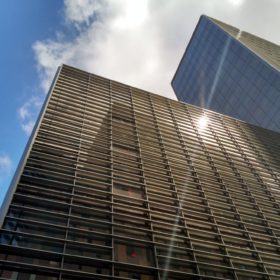
A French-Italian research group has shown that BIPV facades on buildings can cause a ‘darkening’ effect by reducing light reflectance on nearby installations, dragging down energy production by 11%. The ‘urban heat island effect’ can also weigh on PV system performance, the researchers said.
Scientists at Italy’s University of Genova and France’s Savoie Mont Blanc University have conducted a study to assess the performance of building-integrated PV (BIPV) facades in urban environments.
The researchers are trying to understand how urban morphology and microclimates affect solar facade performance. The scientists found that performance could be severely compromised by a “darkening” effect – as well as by the “urban heat island” phenomenon, which results in higher temperatures in urban areas than in rural hinterlands. This occurs when several vertical BIPV installations are located in the same area because of nearly zero-energy building (NZEB) policies.
The darkening effect observed is created by the BIPV facades, which can reduce the light reflectance potential of building surfaces, thus reducing the amount of light reflected onto adjacent structures. The problem will only occur if many or all buildings in an urban district are covered with solar facades, with low-consumption buildings acting as NZEBs, or other self-producing energy units.
Environmental impact
The power output of vertical PV is strictly dependent on surrounding structures and the ground, due to the light they may reflect. “Facades are extremely sensitive to how urban materials react to solar radiation,” the academics said, adding that a previous study showed that highly reflective paint on surrounding rooftops contributed to a 48% increase in power yield in PV facades.
Although facades are not the best surfaces for PV deployment – as their annual solar irradiance is significantly lower than that of horizontally planed rooftop panels – vertical PV installations are a necessity if urban districts are to hit NZEB goals, as rooftop panels alone are not sufficient, the Italo-French research group said. Vertically aligned PV systems also achieve an higher peak irradiance either side of midday than horizontal setups, diminishing the mismatch between energy production and demand.
Analysis tools
The scientists based their analysis on the conversion of an ideal, 11-block urban district of Rome into a self-sufficient energy suburb based on BIPV solutions. The analysis was based on the open-source EnergyPlus whole-building energy modeling software, which was developed by the U.S. Department of Energy and the Urban Weather Generator application, which is used to model the urban heat island effect.
Two district design scenarios were considered. “In the first case, minimum energy efficiency targets are considered; in the second case, a series of urban heat island mitigation strategies are adopted,” the researchers said.
In both scenarios, construction elements such as walls, roofs and windows complied with minimum transmittance requirements under Italian building standards. To calculate the power yield of the PV facades, the researchers used software developed by U.S.-based Sandia National Laboratories.
“The solar potential of the reference building facades has been calculated with the Sandia method, and considering the surface incident solar radiation and temperature of the EnergyPlus simulations,” the researchers said.
Final results
The demonstration showed power production from vertical PV systems in the modeled district could be reduced by up to 11% per PV unit area due to darkening induced by panels on surrounding buildings. The urban heat island effect was observed to drive a further output reduction of 0.3%.
“By varying the reflectivity of surrounding surfaces and [the] ground, the solar energy production per PV unit surface (on the reference building) [was] significantly affected,” the group stated. “Adding, gradually, PV surfaces on both the reference and the adjacent buildings, reduces the conversion capacity of PV surfaces because of the darkening effect associated [with] the low reflectivity of photovoltaic modules, which in turn reduces the available reflected solar radiation.”
By contrast, an increase in PV coverage could drive up solar power generation by 60%, the researchers said. “The above considerations suggest that the best productivity of vertical PV surfaces on the building is related to facade PV coverage [of] up to 40%-60% of the whole available district surface,” they added.
Vertical PV
“If the buildings are of many floors, and not scattered, single-family houses, the roofs are not enough to ensure the electrical [needs] of buildings in a NZEB perspective, even if the district is made from low consumption buildings,” research co-author Marco Fossa told pv magazine.
The need to produce building energy on-site without land consumption will render the use of BIPV facades necessary, Fossa said. “I think this will happen over the next 10 years.”
The researchers presented their findings in “Best arrangement of BIPV surfaces for future NZEB districts while considering urban heat island effects and the reduction of reflected radiation from solar façades,” recently published in Renewable Energy and on the ScienceDirect website.
Lắp đặt điện mặt trời Khải Minh Tech
https://ift.tt/2X7bF6x
0906633505
info.khaiminhtech@gmail.com
80/39 Trần Quang Diệu, Phường 14, Quận 3
Lắp đặt điện mặt trời Khải Minh Tech
https://ift.tt/2ZH4TRU
Không có nhận xét nào:
Đăng nhận xét